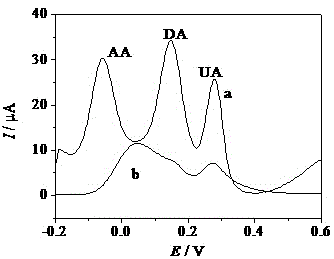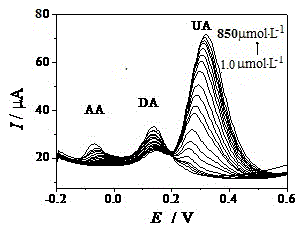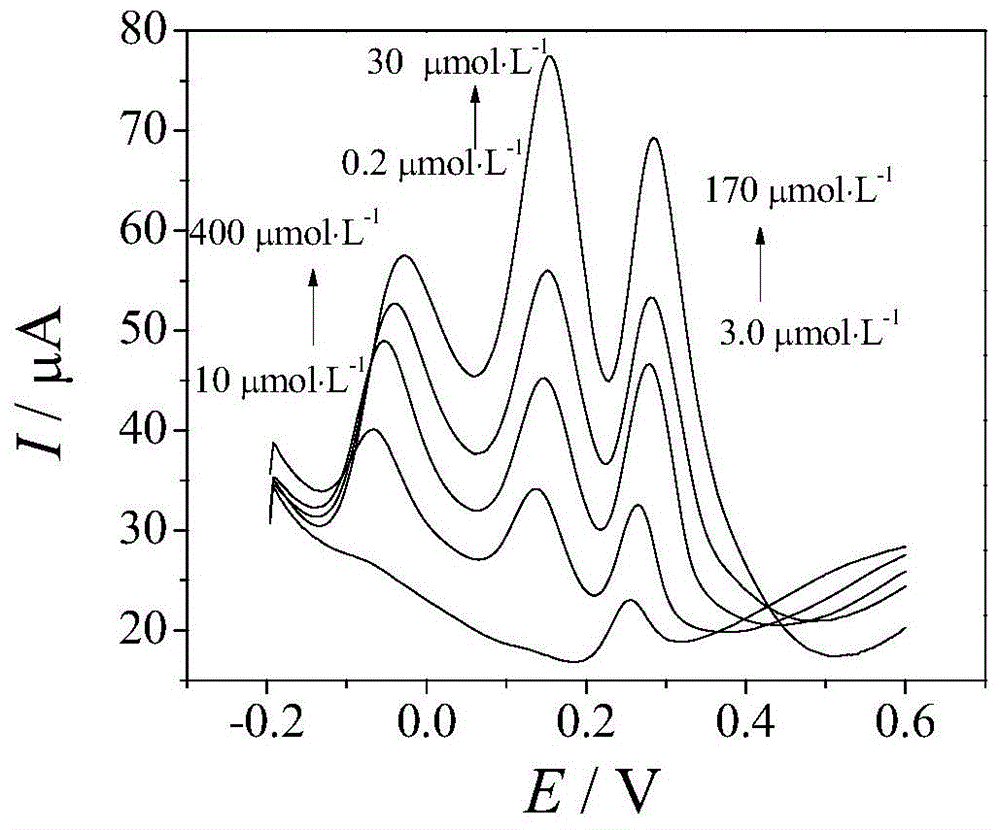Electrochemical sensor capable of simultaneously detecting dopamine, ascorbic acid and uric acid
An ascorbic acid and electrochemical technology, applied in the direction of material electrochemical variables, can solve the problems of selectivity and unsatisfactory detection limit, and achieve the effect of excellent accuracy, uniform film and low detection limit
- Summary
- Abstract
- Description
- Claims
- Application Information
AI Technical Summary
Problems solved by technology
Method used
Image
Examples
Embodiment 1
[0042](1) Synthesis of composites of graphene and mesoporous ferric oxide
[0043] Synthesis of graphene oxide: Mix 0.3 g of graphite powder and 1.8 g of potassium permanganate, put them into a three-neck flask with a magnet, add 40 mL of concentrated sulfuric acid and phosphoric acid mixture with a volume ratio of 9:1 to the above three-neck bottle. Put the three-neck flask into an oil bath, heat it to 50 °C, and react for 12 hours. After the reaction is over, pour the sample onto about 40 mL of ice, and at the same time, put the magnet on the poured ice-water mixture, and slowly magnetically stir , add 0.3 mL of 30% hydrogen peroxide, the ice melts gradually, and magnetically stir for 0.5 h. After the reaction, the obtained mixture was centrifuged at 8000 R for 0.5 h, then washed three times with 20 mL of water, 20 mL of 30% hydrochloric acid, and 20 mL of ethanol, discarded the supernatant, and finally washed with 20 mL of Centrifuge and wash with mL ether, discard the su...
Embodiment 2
[0056] Example 2 The detection of uric acid in the presence of ascorbic acid and dopamine
[0057] According to the steps of Example 1, an electrochemical sensor was constructed for the detection of uric acid. The concentration of DA and AA is fixed, the concentration of UA is changed, and the electrode modified by graphene and mesoporous ferric oxide composites is shown in the differential pulse voltammogram of the three substances. figure 2 shown. Depend on figure 2 It can be seen that the oxidation peaks of the three substances are clearly separated and the peak shapes are better. At 1.0~850μmol·L -1 Within the concentration range, the maximum peak current value of UA is proportional to the square root of its concentration, and the linear correlation coefficient r =0.993, the detection limit is 0.056μmol L -1 .
Embodiment 3
[0058] The detection of ascorbic acid when embodiment 3 uric acid, dopamine exist
[0059] According to the steps of Example 1, an electrochemical sensor was constructed for the detection of ascorbic acid. Fix the concentration of DA and UA, change the concentration of AA, and draw the differential pulse voltammogram of the modified electrode to the three substances. It can be obtained from the figure that in the range of 5.0~1600μmol·L -1 The maximum peak current value of AA within the concentration range is proportional to the square root of its concentration, and the linear correlation coefficient r =0.984, the detection limit is 0.074μmol L -1 .
PUM
| Property | Measurement | Unit |
|---|---|---|
| pore size | aaaaa | aaaaa |
| recovery rate | aaaaa | aaaaa |
Abstract
Description
Claims
Application Information
 Login to View More
Login to View More - R&D
- Intellectual Property
- Life Sciences
- Materials
- Tech Scout
- Unparalleled Data Quality
- Higher Quality Content
- 60% Fewer Hallucinations
Browse by: Latest US Patents, China's latest patents, Technical Efficacy Thesaurus, Application Domain, Technology Topic, Popular Technical Reports.
© 2025 PatSnap. All rights reserved.Legal|Privacy policy|Modern Slavery Act Transparency Statement|Sitemap|About US| Contact US: help@patsnap.com



